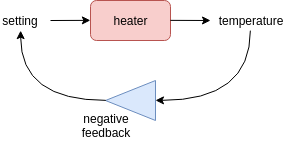
Closed Loops and Tax Policy
Written on

Elected representatives are simply not up to the task of making unpopular decisions, even when those decisions are patently necessary. As a result, they tend to never make decisions like raising taxes, even while the debt continues to increase. This article describes the use of an engineering concept called a closed loop in order to solve an ever-growing tax problem.
What is a Closed Loop?
A closed loop is a system that used output information on order to adjust the inputs. This is an arcane way of saying that the system self adjusts to maintain a particular outcome.
Lets look at the heating system within your house. If your heater is set to 100 BTUs of continuous output, then your house is likely to get very hot in the summer and will likely not get warm enough in the winter.

Fortunately, they have a little device called a thermostat that measures the house temperature and modulates the power of the heater to achieve the desired temperature. The thermostat is closing the loop, using the output temperature to adjust the input to achieve the desired result.

Negative feedback simply means that if the temperature goes up, the setting goes down and vice-versa.
How is This Related to Taxes?
Tax rates in the US are governed by tables that are manually adjusted by legislators, which is an inefficient and error-prone process. This is analagous to setting the heater from above and leaving it until the house gets too hot. It requires continual monitoring and adjustment by a person.
Can a Closed-Loop be Applied to Tax Policy?
Since we are talking about the high-level concepts, lets assume a flat tax for the purposes of the discussion. We will assume a starting tax rate of 15%.
The desired outcome is a balanced budget, which is an annual budget in which the debt is $0, with the income perfectly matching the spending. This is, of course, an ideal that can't be achieved, but we can get close. Applying a closed-loop to tax policy is as simple as implementing two rules:
- In a year in which there is a net debt, tax rates are adjusted up by 1%;
- In a year in which there is a net surplus, tax rates are adjusted down by 1%.
This is a very simple closed loop and it is certain that a more nuanced method would perform more admirably; however, simplicity is highly desired when making government policy. Complexity may temporarily serve valid purposes, but complexity is usually commandeered in order to introduce confusion to push forth other goals. It is imperative that any high-schooler or legislator must be able to easily understand the principles of operation of a government device.
Can a Closed-Loop Apply to Progressive Taxes?

Yes! If tables are used, then the tables could be adjusted each and every year by the correct percentage. This type of closed-loop policy would better apply to a progressive tax that was more formulaic rather than table based, but it does work on tables.
Other Effects
Under an open-loop system, legislators are trying to balance spending - popular or not - with adjusting taxes, which is never popular. As a result, so long as a legislator doesn't have to raise taxes, s/he simply won't do it as the national debt continues to rise. A closed-loop tax adjustment eliminates this problem, when the legislator never having to increase taxes.
Furthermore, spending now becomes the thing that voters scrutinize. Large items will be more highly scrutinized, with all voters knowing that tax rates will adjust appropriately for large expenditures. A war will adjust the tax rate for many years to come, for instance, with no interference from legislators other than the war itself.
How might your opinion change on spending if you knew that every extra dollar spent would directly reduce your annual income a bit?
Conclusions
Any system that is governed solely by people will require constant supervision and tuning. Closing the loop is the only way to minimize the involvement of legislators and always maintain acceptable levels of performance. There might be a better implementation that this, but anything much more complex would also become more difficult or confusing to implement.
Category: taxes.